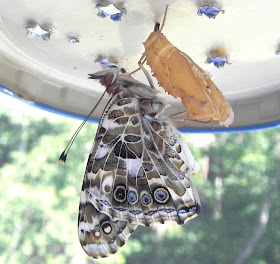28 July 2019
Painted Lady (Vanessa cardui)
I found several eggs on leaves of borage plants in our garden and didn't know what butterfly had laid them. Borage is a common weed, and is used by a wide variety of butterflies as a food plant for their caterpillars. I kept the leaves in a jar, and after a while some small black caterpillars emerged. began eating voraciously, and grew much larger.
They look ferocious, but were no problem to raise except for their copious, wet, messy frass that required frequent cleaning and changing of the container (other caterpillars, like the Polyphemus silkmoth ones, excrete dry little pellets that resemble pepper grains and are easy to clean up after).
When they were full size, the caterpillars climbed to the lid on the jar, hung in a "J" shape, and proceeded to undergo that remarkable metamorphosis that is endlessly fascinating to me - the formation of a chyrsalis.
I didn't know how long the conversion to a butterfly would take. With Monarchs, it's easy to tell by looking at the outside of the chrysalis when the butterfly is ready inside; with these it was more difficult. But all one has to do is wait...
... and voila! One morning, there she is, wings hanging down. By the time I found her she had pumped the fluid into the wings, which were fully inflated but not yet dried. She was docile and not ready to fly, so she readily transferred to my finger for a portrait:
The pattern is quite beautiful and intricate close-up (much harder to appreciate in the field when she tends to be a blur of activity, but easier here where you can enlarge the image with a click). She is closely related to the American Lady (whose life-cycle I documented two summers ago) and looks rather similar top-side, but on the underwings this Painted Lady has four eyespots on the hindwing, while the American Lady has two larger ones.
Painted Ladies are very common in the United States, and with Monarchs are probably the two butterflies most often raised in classrooms by small children. Kits are available from Carolina Biological Supply and other sources; these contain food in the form of a sort of agar, which is all the caterpillars need for nutrition, so you don't have to scour the wilds of your neighborhood looking for food plants. Raising them is a pleasant diversion for small children. And for some adults.
Reposted from 2012 to add some additional photos:
I was weeding the garden today when a Painted Lady arrived. She was actively nectaring on the coneflowers and Monarda and sat for the above portrait that is rather better than the original one at top. At one point I was also able to obtain a backlit view -
Note the four small eyespots on the back of her lower wing - these distinguish her from the very similar-looking American Lady, which has two large eyespots in that location.
After nectaring she got busy ovipositing on a variety of plants in the garden, but especially on some scrawny Pearly Everlastings (Anaphalis). Like the American Ladies, the Painted Ladies oviposit on the top of the leaves, so it was easy for me to spot the eggs. I brought one leaf into the house in order to photograph the egg with my desktop digital microscope:
The egg in terms of size, shape, color etc looks quite like the American Lady eggs (see my 2010 photoessay). But the microscope revealed what I had not seen before - that the egg is actually deposited beneath the network of soft hairs that coat the leaves of the Pearly Everlasting. The first instar will hatch into a semi-protected environment. Fascinating. I've never seen that before.
(some reader may know the technical term for those "hairs" that cover the leaves - I'd like to amend the text accordingly. Tx in advance)








Beautiful!!!
ReplyDeleteYour fingernail is well manicured!
ReplyDeleteI "hatched" (what do you call it when you keep a caterpillar through metamorphosis?) an American Lady a few years ago, and it was the only time I've ever done it. A great experience to go through! I'd love to do it again sometime.
ReplyDeleteI 'raised' 4 PLs from a Nature Company kit a while back ~ loved it!!
ReplyDeleteThis adult would love to do it again!
We used to raise/hatch/babysit monarch caterpillars into butterflies when I was a kid. I think it's a great thing to do.
ReplyDeleteI have to say this blog has given me a greater appreciation of moths and butterflies.
I'm glad to hear that, xenotropos. You create interesting artwork, btw; perhaps I will borrow your butterfly someday...
Deletei raise these with my first grade science students each year. every student gets on larva to observe from when they arrive at just a few millimeters in length until we release the adults in our butterfly garden. a beautiful insect and a great activity for young naturalists!
ReplyDeleteLOL @ Kolo Jezdec!! Thanks for the giggles!
ReplyDeletei have several question marks flying around in my yard. they are more gregarious than red admirals! and you don't have to salute them, either. :-)
ReplyDeleteI-)